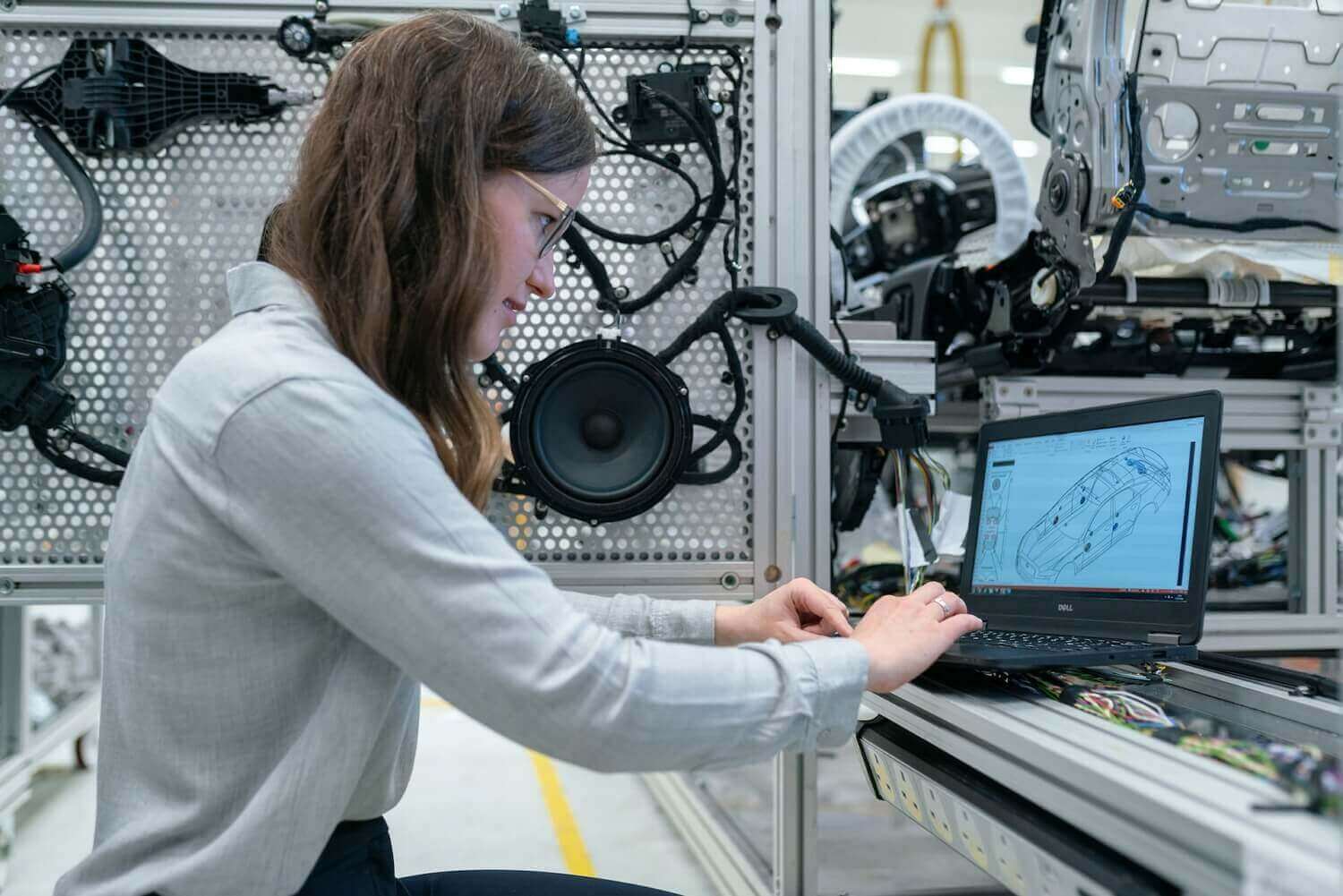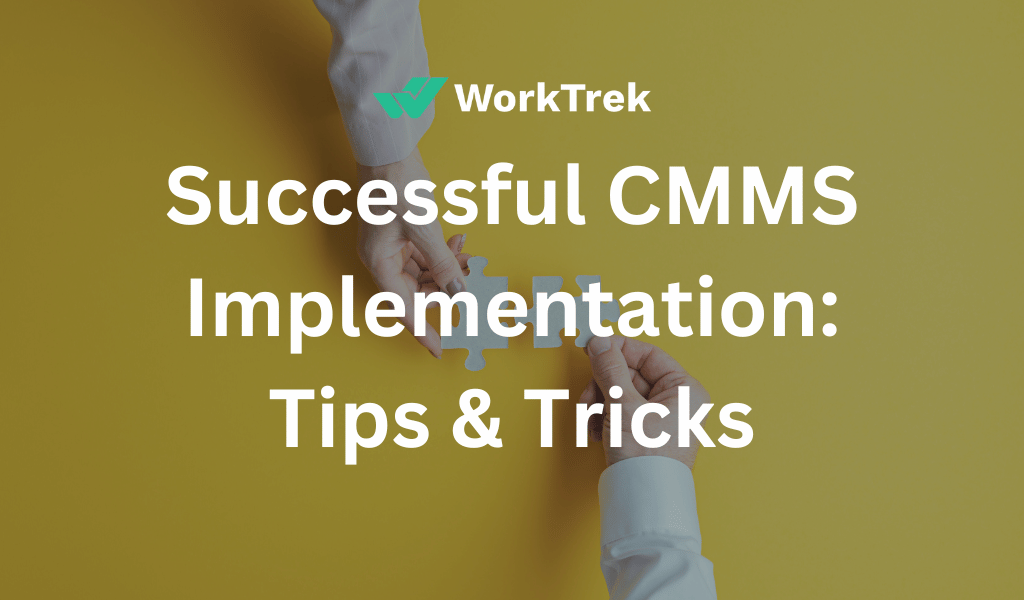Get a Free WorkTrek Demo
Let's show you how WorkTrek can help you optimize your maintenance operation.
Try for freeA CMMS is a powerful and essential software for many companies. However, to get the most out of this tool, it is important to have a successful implementation.
In this article, we’ll look at the advantages and benefits that a good implementation can bring to a business. We will also discuss the best practices to apply to obtain the best possible results.
What Is A CMMS?
Computer Maintenance Management System (CMMS) groups are software solutions that help companies manage their processes and operations. A CMMS is designed to improve the efficiency, productivity, and quality of a company’s processes and operations. It also reduces costs and increases return on investment.
A Computer Maintenance Management system allows companies to plan and manage their operations, allocating the necessary resources to achieve their objectives. A CMMS provides businesses with complete visibility into all processes and operations through tools such as detailed reports, analytics reports, and key performance indicators.
It can also be used to automate certain tasks, which can help reduce downtime and improve efficiency. The implementation of a CMMS can also improve decision-making and the execution of tasks within the company.
Indeed, it offers companies a more in-depth view of their activities, which allows decision-makers to have a better understanding of the risks incurred and the opportunities to be seized. The data collected and generated by a CMMS can also be used to make better and more informed decisions about which strategies to implement.

Why Is It Important?
In addition, a CMMS improves the consideration of the complete life cycle of a company’s assets. Indeed, it facilitates the planning and implementation of an effective maintenance program for each asset so that it can function properly for a long time. The data collected by a CMMS can also be used to monitor asset performance, allowing companies to take appropriate action to prevent any malfunction or potential failure before it occurs.
Therefore, a successful CMMS implementation is essential to ensure that your business operates efficiently and achieves its goals. This will not only take your organization to a higher level of productivity but also increase its profitability by reducing its overall operational costs.
Additionally, making optimal use of existing assets will allow your business to maintain its competitive advantage in the marketplace by increasing its ability to innovate and provide exceptional customer service.

The Key Steps For A Successful CMMS Implementation
The key steps for a successful CMMS implementation are crucial step for the success of any CMMS system.
A good understanding of the steps to follow is essential to maximize the benefits of using a CMMS.
The key steps to follow help ease the implementation process and ensure that the system is implemented correctly to ensure maximum return on investment.
- First, it is important to define the goals of the project and understand how the CMMS system can help achieve those goals.
Once these goals are defined, a plan will need to be developed to achieve these goals. This plan should include an analysis of existing processes, as well as an assessment of the tools needed to complete the project. Once these steps are completed, a budget and schedule will need to be established to ensure the project is completed on time and to specification. - Once the preliminary steps have been completed, work can begin on the system itself.
It is essential to choose software adapted to the specific needs of the project that will offer practical and effective solutions. The software should be easy to use and provide useful features that will allow users to increase their productivity. - Once installed and configured, the CMMS should be tested and validated before it goes into production.
This will allow users to ensure that all necessary features are available before a full launch. When the system is operational, it is important that users can use it effectively so that it is profitable. Appropriate training should be provided so that all employees can understand how to properly use and benefit from CMMS. In addition, technical support must be provided to quickly resolve any problems related to the system or its use. This will ensure that the CMMS will always be operational and will help maintain a high level of efficiency within the professional services provided. - Finally, it is important to ensure that the system is updated regularly so that it can benefit from the latest technological innovations and continuously improve its performance.
Updates may include software fixes, hardware updates, or improvements to existing processes. Regular updates will also improve the overall user experience and ensure continued customer satisfaction with the service provided by the CMMS.
A successful CMMS implementation, therefore, requires careful planning and attention to detail to ensure that the system will successfully fulfill all of its objectives. By following these key steps, you can ensure your CMMS is set up to provide the best employee experience and maximum ROI for your business.

The Benefits Of A Successful CMMS Implementation
Successful implementation of a CMMS can bring many benefits to a company.
- First, a CMMS can improve technician productivity by automating repetitive tasks such as work scheduling and data entry.
- It can also provide technicians with easy access to relevant information on spare parts and diagnostic methods so they can solve problems more quickly and efficiently.
- The real-time data updates provided by the CMMS allow technicians to access the information they need instantly, which improves decision-making.
- In addition, the use of a CMMS helps to streamline the process of planning and budgeting maintenance activities.
- With the app, managers can get a clear and comprehensive view of maintenance-related costs and set an appropriate budget for different tasks.
- The intuitive features offered by the CMMS allow managers to easily track inventory consumption, repair schedules, and the time spent by technicians on each project.
- Additionally, a CMMS can help increase asset availability through its ability to generate accurate reports on equipment condition and performance. These reports allow managers to quickly identify malfunctions and fix them before they become more serious or lead to a service interruption.
- CMMS can also provide a holistic view of the maintenance schedule, allowing companies to get work done accurately so assets can operate without disruption.
- Finally, the use of a CMMS can help improve occupational health and safety by providing technicians with detailed information on the correct operation of equipment and its associated procedures.
CMMS systems can include comprehensive monitoring of monthly inspections and tests as well as alerts in the event of malfunctions to ensure that all assets comply with current occupational health and safety standards.
In sum, the successful implementation of a CMMS can provide several benefits for a business, including productivity, budget planning, asset availability, and occupational health and safety.
A CMMS can provide businesses with a complete solution to ensure that all of their assets are running smoothly and safely while optimizing their overall productivity and operational efficiency.

The Main Obstacles To A Successful Implementation Of A CMMS
A CMMS can benefit companies wishing to optimize their maintenance and management processes.
However, to fully benefit from these advantages, the CMMS must be correctly implemented.
Unfortunately, this is not always the case as several obstacles can present themselves and contribute to an implementation failure.
- One of the main obstacles is the provider’s lack of understanding of business needs and objectives.It is essential that the supplier clearly understands the expectations and objectives of the customer to be able to offer a solution adapted to their specific needs. If the needs are not properly identified or if the expectations are not communicated to the supplier, there is a risk that the proposed solution will not meet the customer’s expectations.
- Poor planning and inexperience can also be barriers to successful implementation.Planning is fundamental to ensure that all aspects necessary for a good implementation are taken into account and respected. It is therefore important that the project be well-planned and documented to ensure a smooth and successful transition to the new CMMS solution. Additionally, poor planning can lead to delays, which can lead to additional costs for the business. Finally, inexperience significant in terms of implementation can be an additional obstacle to the success of the project. An experienced service provider will be able to guarantee the rapid and efficient implementation of the CMMS solution.
- Another obstacle that can arise is the lack of an adequate training strategy for end users.
Training is essential to ensure the proper functioning and optimal use of the CMMS solution. Without proper training, users may not understand how to use the solution or how to get the most out of it to achieve their goals. Therefore, the service provider must offer comprehensive training to end users on how the CMMS works as well as on the different functionalities it offers. - In addition, the lack of adequate IT infrastructure can also be a barrier to successful implementation.
Appropriate IT infrastructure is necessary to ensure the proper functioning and deployment of the CMMS. If the IT infrastructure is not adequate, this can lead to serious technical problems that can affect the deployment of the CMMS solution or even lead to its complete failure. - The last major difficulty that can prevent the successful implementation of a CMMS lies in the lack of interest or commitment of the stakeholders concerned by the project.
When all stakeholders are not fully engaged or interested in the project, it can lead to a lack of communication, which makes it very difficult to effectively coordinate efforts between different parties regarding the implementation and correct use of the solution.

In conclusion, there are several obstacles to a successful implementation of a CMMS such as the lack of understanding of the needs and objectives of the service provider, inexperience in terms of implementation, a lack of ad hoc training for end users, a bad deployment or even a lack of commitment of the stakeholders concerned by the project.

CMMS implementation is easy with WorkTrek's expert guidance!
Book a WorkTrek demo to see how a CMMS can help your maintainability.
Try for freeHow To Guarantee A Successful Implementation Of A CMMS?
Ensuring a successful CMMS implementation requires careful planning and preparation.
It is essential to take the time to carry out due diligence that defines the processes, procedures, and tools necessary to integrate the CMMS into the organization.
Once these steps have been completed, implementation personnel should proceed to analyze existing data and identify potential technical gaps and barriers.
Finally, it is essential to create an implementation plan and review each step of the process to ensure project cohesion. Once the program has been established, it’s time to begin the actual implementation.
- The first step is to develop the CMMS system using appropriate software.
This may involve setting up a computer network or creating a centralized database. Implementing personnel must ensure that the system meets the standards required to ensure its reliability and efficiency. - Once the system is in place, it is important to properly train the employees who will be using the system so that they understand how to use it correctly and can take advantage of the benefits CMMS offers.
- Implementers should also ensure that the system is properly integrated with the existing IT infrastructure and that it is compatible with all other systems and tools used by the organization.
He must ensure that all data stored in the system is secure and accessible to authorized persons. In addition, the necessary security measures to protect against external threats must be put in place. - Once the system is operational, regular testing should be carried out to ensure that it operates correctly and without interruption.
Testing can be performed manually by implementation personnel or by specialized software. The tests should be designed to cover the entire system so that no bug goes unnoticed and compromises its optimal functioning. It is also important that the tests are carried out with frequency to ensure that the system remains efficient and flawless after each minor or major upgrade or update. - Finally, the successful implementation of a CMMS also involves the implementation of a continuous improvement process.
This will include regular analysis of system performance as well as prompt resolution of issues that arise to maintain a high level of operational efficiency, promptly fixing bugs and continually improving the software as needed by the organization.
Successful implementation of a CMMS offers many advantages to improve the functioning of companies. Processes are automated and streamlined, data is more accessible and secure, and performance is optimized.
CMMS can also reduce costs and streamline operations, making it a great investment. Moreover, the implementation of a CMMS can be customized according to the specific needs of the company, which makes it even more profitable.









